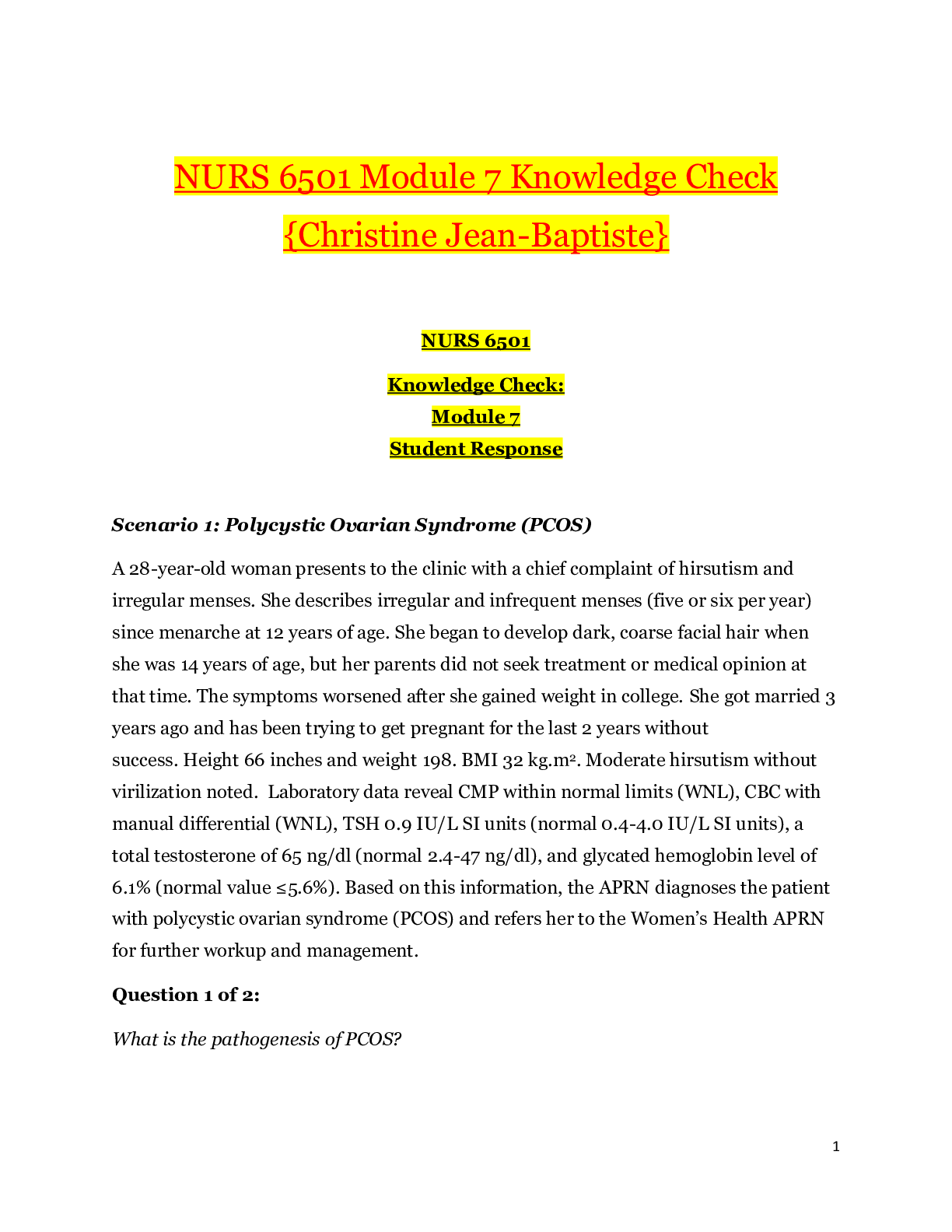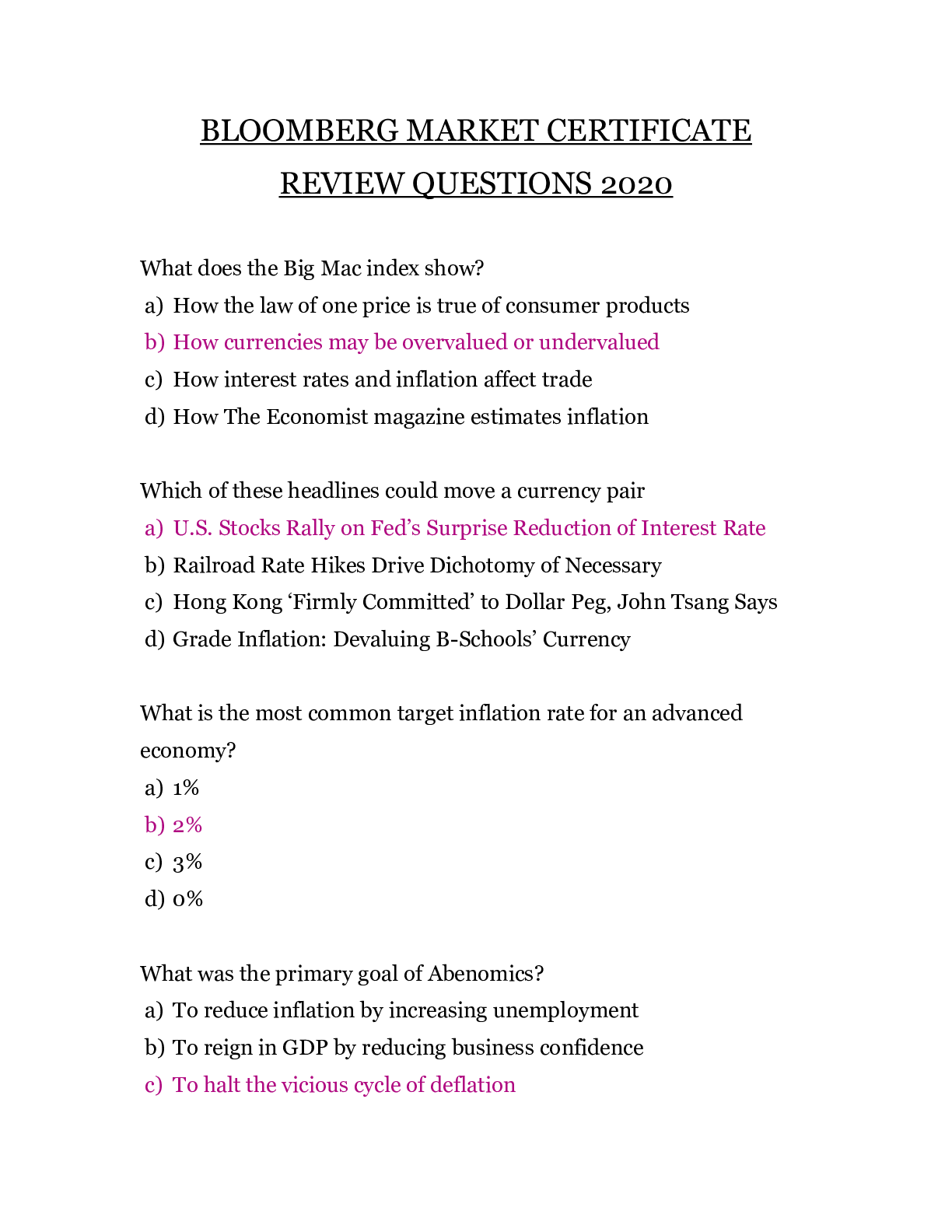*NURSING > EXAM > NR 566 weeks 1-3 midterm review questions_2020 | NR566 weeks 1-3 Midterm review questions_Graded A (All)
NR 566 weeks 1-3 midterm review questions_2020 | NR566 weeks 1-3 Midterm review questions_Graded A
Document Content and Description Below
NR 566 weeks 1-3 midterm review questions Week 1 Professor question: Why are statins recommended in the evening instead of morning? (pg 561) After starting John on insulin, he calls the office... saying he feels bad. He said when he checked his blood sugar before calling it was 52 mg/dl. What instructions should he be given? Answer from classmate: Statins are recommended to be taken in the evening. Cholesterol synthesis is highest through the night and first thing in the morning. The biosyntheses of cholesterol follows a normal circadian rhythm. Administration at night allows for the medication to be at peak levels in the body during the time of high cholesterol synthesis (Korani et al., 2019). A blood glucose level <70mg/dL is considered to be hypoglycemia. John called the office with a sugar of 52mg/dL. He would be given instructions that follow "the rule of 15". This means that when symptoms occur, he should consume 15 g of a fast-acting carbohydrate. After 15 minutes, he should recheck his blood glucose. John should also be educated on the best options of carbohydrates to consume. Examples would be 4 oz of juice, four-five hard candies, honey, or half a can of regular soft drink. Another education point is that John needs to have a meal within a few hours after the low blood glucose. He may also need to see his doctor for adjustments to be made on insulin dosage as well as meal patterns to help prevent another low blood glucose episode from occurring (Woo & Robinson, 2016). Professor question: What diabetic medications would be contraindicated in patients with heart failure? Which diabetic drug(s) may have beneficial effects in heart failure? (text has info on this but ADA 2020 guidelines has even more up to date info on this topic, so here is the page. See Recommendation 9.9 and 9.10) https://care.diabetesjournals.org/content/43/Supplement_1/S98 answer from classmate: Suppose John was showing signs of heart failure. What diabetic medications would be contraindicated in patients with heart failure? Metformin is contraindicated in patients with renal insufficiency and unstable heart failure (Woo & Robinson, 2016). According to the American Diabetes Association (2020), Metformin can be utilized in patients with stable heart failure, not currently hospitalized, and Glomerular filtration rate should be greater than 30 ml per hour. In this instance, John should be switched to fast acting insulin Humalog, to cover mealtimes and if his HgbA1C is not sufficiently controlled at the 3 month follow up then, long acting Lantus insulin should be added to the regime. Additionally, John should be placed on an Angiotensin Converting Enzyme inhibitor or Angiotensin Receptor Blocker and likely increase his atorvastatin to 20mg tablet (ADA, 2020). Which diabetic drug(s) may have beneficial effects in heart failure? With the scenario presented previously and with the addition of heart failure, John should be placed on either a sodium-glucose cotransporter 2 inhibitor (SGLTi) or a glucagon-like peptide 1 receptor agonist (GLP-1 RA) to improve glycemic management (ADA, 2020a). Both SGLT2i and GLP-1 RA have demonstrated cardiovascular disease benefits by reducing CVD events and HF hospitalizations in association with diabetes mellitus (ADA, 2020b). The differential in which medication to use for John would be based on his Glomerular Filtration Rate (GFR), decreasing GFR rates or worsening chronic kidney disease would indicate stoppage of SGLT2i and use of GLP-1 RA. Per the American Diabetes Association (2020), John with mild HF would be initially placed on a GLP 1- RA Liraglutide (Victoza). Victoza is a once daily injection that aids in treating T2DM by increasing insulin synthesis and release, decreasing amount of glucagon and gastric emptying, and reducing food intake (Woo & Robinson, 2016). Additionally, placing John on a GLP-1 RA would help decrease his obesity with its proven beneficial tendency to increase metabolism and improve weight loss (Woo & Robinson, 2016). Professor question: What lab do we need to check prior to starting metformin? (hint: which organ function needs to be evaluated?) What other potential adverse effects are there associated with metformin? (Micromedex in the library is a good source for this info) Answer: The most important lab is eGFR/renal function since this determines whether we can safely use metformin. See recommendations below. I also included information on contrast administration. The concern is that if dye impairs renal function, the risk of lactic acidosis is increased. Another potential adverse effect is B12 deficiency. "Clinical recommendations based upon the patient’s renal function • Before initiating therapy, obtain an eGFR • Initiation of therapy is not recommended in patients with eGFR between 30 –45 mL/minute/1.73 m² • Obtain an eGFR at least annually in all patients receiving therapy • In patients at increased risk for development of renal impairment (e.g., the elderly), renal function should be assessed more frequently • If eGFR later falls below 45 mL/minute/1.73 m², assess benefit and risk of continuing therapy Iodinated contrast imaging procedures • Discontinue metformin at the time of or before an iodinated contrast imaging procedure in patients with an eGFR between 30-60 mL/minute/1.73 m²; in patients with a history of liver disease, alcoholism, or heart failure; or in patients who will be administered intra-arterial iodinate contrast • Reevaluate eGFR 48 hr after the imaging procedure; restart metformin if renal function is stable" • https://reference.medscape.com/drug/glucophage-metformin-342717 Professor question: The GLP1RA class drugs end with "-tide". They are highly recommended as a second agent after metformin by both ADA and AACE/ACE guidelines. Per ADA guidelines: • 9.9 Among patients with type 2 diabetes who have established atherosclerotic cardiovascular disease or indicators of high risk, established kidney disease, or heart failure, a sodium–glucose cotransporter 2 inhibitor or glucagon-like peptide 1 receptor agonist with demonstrated cardiovascular disease benefit (Table 9.1 (Links to an external site.), Table 10.3B (Links to an external site.), Table 10.3C (Links to an external site.)) is recommended as part of the glucose-lowering regimen independent of A1C and in consideration of patient-specific factors (Figure 9.1 (Links to an external site.)). A • 9.10 In patients with type 2 diabetes who need greater glucose lowering than can be obtained with oral agents, glucagon-like peptide 1 receptor agonists are preferred to insulin when possible. B Unfortunately these agents are very expensive, from about $700-1,200/month which will make them unaffordable for many patients if insurance does not cover the cost. It is such a shame that cost factors into prescribing! according to the text, what effect does carbamazepine have on thyroid function tests? What is the difference b/w total and free T4? P 1181 Table 41-1 Answer from classmate: According to the text, carbamazepine decreases the serum concentration of thyroid hormones. It is proposed that carbamazepine increases the extra-thyroidal metabolism of thyroid hormones (Woo & Robinson, 2016). Total T4 measures the bound and free thyroid hormone and can change when binding proteins differ. Free T4 measure what is not bound and able to enter and affect the body tissues. The normal range for Free T4 is 0.7-1,86 ng.dL (9-24 pmol/L) In hypothyroidism, you would expect the Free T4 to be low whereas in hyperthyroidism, you would expect the Free T4 to be high. Professor question: Can you review in our text the sulfonylurea class? What is the MOA, what are some examples? What are the adverse effects? Thanks!! Answer from classmate: According to the text, the sulfonylurea class was the first class of oral drugs developed to help manage blood glucose levels in patients with type 2 diabetes mellitus. This class of drug has shown to be similarly effective as metformin and have the ability to reduce HbA1c levels by about 1,5%(Woo & Robinson, 2016). This class of drug’s mechanism of action is the increase the secretion of insulin via the stimulation of beta cells of the pancreas (Costello & Shivkumar, 2020) thus it is important that the patient is still able to produce some endogenous insulin. The drugs improve the binding between the insulin and the insulin receptors thus improve the utilization of the insulin to a certain extent (Woo & Robinson, 2016). These drugs may also enhance the effect of the diuretic hormone and have a slight diuresis effect. Sulfonylureas are recommended as a co-therapy, the drug is not as effective as a monotherapy since it is unable to sustain glycemic targets over time(Woo & Robinson, 2016). Some examples of sulfonylurea drugs are: Chlorpropamide, Tolazamide, Glipizide, and Glimepiride Professor question: If our patient had HF and Afib, he might be on digoxin. What medication for DM can decrease digoxin levels? (class and examples) Pg 579 Classmate answer: Acarbose and miglitol decrease digoxin levels when given together. Acarbose and Miglitol are oral antihyperglycemic drugs that treat type II diabetes and are classified as alpha-glucosidase inhibitors. These drugs competitively inhibit the absorption of complex carbohydrate from the small intestines. This result in delayed digestion of carbohydrates causing flatulence. Alpha-glucosidase inhibitors lower blood glucose after meals. Since this class of drugs reduce digoxin concentrations thus reduce effect, it is recommended to choose another antihyperglycemic drug that does not interact with digoxin. These drugs are gives as an adjunct with other therapy for type II diabetes. The most common adverse reactions are GI disturbances but these side effects cab be reduces if the dose is titrated slowly. Professor question: Jason- glad you recognized that contrast dye can be an issue for patients on metformin. Can you read this (older, I know) article that explains why it is a concern rather than binding with contrast dye? Classmate answer: Wow, I am [Show More]
Last updated: 2 years ago
Preview 1 out of 27 pages

Buy this document to get the full access instantly
Instant Download Access after purchase
Buy NowInstant download
We Accept:

Reviews( 0 )
$13.00
Can't find what you want? Try our AI powered Search
Document information
Connected school, study & course
About the document
Uploaded On
Mar 10, 2021
Number of pages
27
Written in
Additional information
This document has been written for:
Uploaded
Mar 10, 2021
Downloads
0
Views
74

.png)















